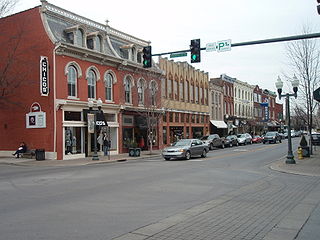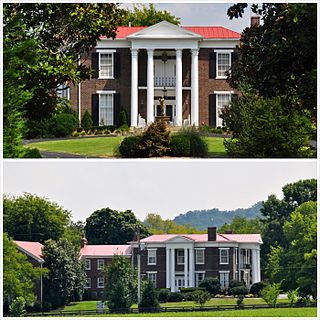
The Carter House State Historic Site is a historic house at 1140 Columbia Avenue in Franklin, Tennessee. In that house, the Carter family hid in the basement waiting for the second Battle of Franklin to end. It is a Tennessee Historical Commission State Historic Site, managed by the non-profit organization The Battle of Franklin Trust under an agreement with the Tennessee Historical Commission. The house is a contributing property and centerpiece of the Franklin Battlefield, a U.S. National Historic Landmark historic district.

The John Hunter House, also known as McCullough House, near Franklin, Tennessee is an Italianate style house that was built in 1875. It was listed on the National Register of Historic Places (NRHP) in 1988.
Seven segments of the historic Natchez Trace are listed on the National Register of Historic Places (NRHP). Also there are additional NRHP-listed structures and other sites along the Natchez Trace, which served the travelers of the trace and survive from the era of its active use.

The William Boyd House, also known as All Bright Hill, is a circa 1800 double-pen house in Franklin, Tennessee, United States.

Fort Granger was a Union fort built in 1862 in Franklin, Tennessee, south of Nashville, after their forces occupied the state during the American Civil War. One of several fortifications constructed in the Franklin Battlefield, the fort was used by Union troops to defend their positions in Middle Tennessee against Confederate attackers. The Second Battle of Franklin in 1864, part of the Franklin-Nashville Campaign in the Western Theater, was the most notable engagement of this area during the Civil War.

The Apheus Truett House ia a frame house located at 228 Franklin Road in Franklin, Tennessee, that was listed on the National Register of Historic Places (NRHP) in 1988. Buit in 1846, it is a notable example of a two-story vernacular I-house structure in Williamson County. It includes Central passage plan architecture. The NRHP listing is for an area of 5.2 acres (2.1 ha), with one contributing building and two non-contributing structures.

Glen Echo, also known as Harpeth Hall, is a property in Franklin, Tennessee that was listed on the National Register of Historic Places in 1976. It is a former plantation house that is now the centerpiece and administrative office of the Battle Ground Academy campus.

Roper's Knob Fortifications were constructed by Union Army forces between February and May 1863 in Franklin, Tennessee. According to Tennessee Archaeology, "Roper's Knob served as part of a chain of signal stations that provided a communications link from Franklin to Murfreesboro. Additionally the knob had a large redoubt capable of holding four large artillery pieces, a blockhouse, cisterns, and a magazine. ... "

Franklin Historic District is a historic district in Franklin, Tennessee that was listed on the National Register of Historic Places in 1972. It was created to preserve historic commercial and residential architecture in a 16-block area of the original, downtown Franklin around the north, west, and south of the town square.

The Harrison House is historic slave plantation home property in Franklin, Tennessee that was listed on the United States National Register of Historic Places (NRHP) in 1975. It was built perhaps in 1810 and was extended and remodelled in 1848 by William Harrison. The remodelling added a "two-story entrance portico and second-story gallery porch typical of many antebellum homes."

The Samuel S. Morton House is a property in Franklin, Tennessee that was listed on the National Register of Historic Places in 1988. It has also been known as Lillie House.
The David McEwen House is a property in Franklin, Tennessee, United States that was listed on the National Register of Historic Places in 1988. It dates from c.1798. It includes Dogtrot log cabin architecture.
The Christopher McEwen House was a property in Franklin, Tennessee that was listed on the National Register of Historic Places, but later was removed from the Register, in 1995.

Thomas Shute House is a property in Franklin, Tennessee, United States, that was listed on the National Register of Historic Places in 1988. The property has also been known as Creekside. It dates from at c.1845. When listed the property included three contributing buildings, and two contributing structures on an area of 4.8 acres (1.9 ha). The property was covered in a 1988 study of Williamson County historical resources. It is one of about thirty "significant brick and frame residences" surviving in Williamson County that were built during 1830 to 1860 and "were the center of large plantations " and display "some of the finest construction of the ante-bellum era." It faces on the Franklin and Columbia Pike that ran south from Brentwood to Franklin to Columbia.

The James Johnston House is a property in Brentwood, Tennessee that dates from c.1840 and that was listed on the National Register of Historic Places in 1976. It has also been known as Isola Bella.

The Lamb–Stephens House is a property in Franklin, Tennessee that dates from c. 1820. It was listed on the National Register of Historic Places from 1988 until 2011.

The H. G. W. Mayberry House, also known as Beechwood Hall, is a historic antebellum plantation house built in 1856 in Franklin, Tennessee.

The Owen Chapel Church of Christ is a property in Brentwood, Tennessee that was built c. 1860 and that was listed on the National Register of Historic Places in 1986. It includes Greek Revival and "Vernacular Greek Revival" architecture.

Mooreland is a property in Brentwood, Tennessee that was built c.1838 and that was listed on the National Register of Historic Places in 1975.

Mountview is a property in Brentwood, Tennessee that was built in 1860 and that was listed on the National Register of Historic Places in 1986. It has also been known as the Davis-Rozelle Residence.















